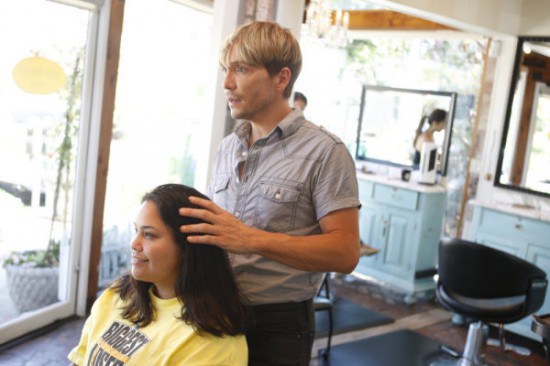
Biggest Loser Season 10 Episode 10
“It’s A Beautiful World We Live In”
Last night, while most American households watched Bristol Palin lose the Dancing With the Stars finale, some of us finally learned how to pronounce the name of Ken Paves, noted Jessica Simpson hanger-on (and creator of Simpson’s low-rent hair-extensions line).
It’s Pave-iss.
Ken was on hand to help the seven remaining Biggest Loser dieters because it was makeover week.
“I’m gonna be beautiful tomorrow,” declared a triumphant Elizabeth.
But was she really more beautiful in her strange new plus-size clothes? Stylists gave her a cheap-looking, printed-pattern sweater and office-worker slacks with an oddly placed thin belt, plus a long shirt which resembled a short skirt.
There’s a reason the average American woman wears a size 14, yet clothing above size 14 represents only 18 percent of sales: there are few great clothing options for plus-size women, a problem documented carefully in this New York Times Magazine piece.
So while Marc Jacobs’ business partner Robert Duffy tantalizingly tweets of a possible plus-size line, American women are relegated to low-cost, ill-fitting pieces from Lane Bryant or mega-expensive, loose-fitting therapist wear from J Jill or Eileen Fisher. In 2005, H&M discontinued plus-sizes entirely, while J. Crew and Ann Taylor recently moved them to online-only.
The makeovers provided this week’s tender spot, as loved ones visited and waxed poetic about the dieters’ new attractiveness and desirability. But the subtext was unmistakable. In nine weeks, the dieters had lost weight ranging from 113 to 43 pounds and with their new skinniness came new responsibilities—to “work it,” to look and feel sexy, to be praised and validated.
“Talk about self-esteem issues: [Elizabeth] doesn’t have any,” said Bob, as she catwalked the big girl runway.
Maybe she does, maybe she doesn’t. But living in a world where you can’t easily buy a pair of pantyhose or a jacket that fits comfortably sends most women a message that’s clearly destructive to their self-esteem—as consumers, you are marginal because of your weight.
Lisa fared better in the plus-size clothing lottery, with a pair of skinny jeans and a leather jacket. Viewers were treated, yet again, to the story of her daughter Nikki crash-dieting due to the horror of having a fat mom. In the show’s final scene a voted-off Lisa returned home, saying to her daughter: “I don’t want to be lazy. I don’t want to be fat. I don’t want to be an embarrassment.”
This is the confusing line that last night’s episode walked: weight loss for beauty, weight loss for health, or weight loss for prize money. As Staten Island bruiser Frado cured his diabetes, motherless Ada felt pretty for the first time, and Beantown schemer Brendan likened the show to a chess game, Episode 10 recklessly veered across all channels, and the result provided no real help to the millions of viewers struggling with weight and other health issues.
In a country where the average woman weighs 165 pounds and is bombarded with media images of women who look nothing like her, very few people need a reminder that it’s a self-esteem boost to lose weight, or that you will look better, or that you will be able to wear nicer clothes, or that your family will be prouder of you. These messages are just a pile-on.
A little validation and support for the physical beauty of the contestants even at their heaviest, on the other hand, would have been truly revolutionary. But of course, that isn’t The Biggest Loser’s game. It’s a profit-making show about tears, emoting, the words “hope” and “journey,” and endless, endless product placement.
Was I the only one who noticed the Smashbox logo float across the screen so quickly that it seemed straight out of Subliminal Seduction, or the drive-by close-up of Extra dessert-flavored gum, a truly frightening product featured in a previous episode?
What no one missed this week was the constant and prominent placement for Ford and their “Warriors in Pink” promotion, benefiting Susan G. Komen, the breast cancer fundraising juggernaut.
This included an infomercial within the show starring the host and two trainers urging viewers to complete monthly breast self-exams, a practice which results in more biopsies but has not been shown to improve outcomes overall.
Even on Komen’s own site, the considerable problems with the test are acknowledged.
So why are the three stars of The Biggest Loser telling millions of women to do the test? As a transition to a commercial for Ford, of course. Viewers should do a useless breast self-exam and then go buy a charity t-shirt from the Ford website. It’s just another example of the show’s shallow treatment of an important subject.
Take the makeover theme. Rather than have a conversation about what constitutes actual beauty, the contestants are encouraged to consume beauty and grooming products, many of which are full of dangerous toxins, a grossly underreported fact.
Lipstick, for example, the ultimate staple of any makeover, contains lead. In 2009, the FDA found lead in all the lipsticks that it tested. There is no safe level for lead exposure. The average American woman consumes around four pounds of lipstick in her lifetime. Children play with it. The government has taken no action on the FDA’s findings to date.
Yet scientists continue to study the effects of all these toxins on our bodies. And they are finding a disturbing link—to obesity.
Susan Luck, RN, MA, HNC, CCN, www.intergrativenursecoach.com, who has written extensively on the topic, adds:
“Unless we address the exposures to toxic chemicals found in everyday products and the environment that may be interfering with human health, the obesity epidemic globally will continue to grow.
“Research into the chemicals hidden in foods, in the home, and absorbed into the skin are well-documented as a hidden cause for increasing rates of obesity, beginning in childhood and continuing throughout the lifecycle. Unknowingly, many people are ingesting and absorbing these chemicals many times every day and they are getting stored in body fat, disrupting normal fat cell metabolism and unknowingly adding on the pounds.
“Scientists recently termed these chemicals that contribute to weight gain obesogens, also categorized as endocrine disruptors in the medical literature.” (Read more in the Earthrose Institute’s Newsletter archive; “Toxins and Obesity,” Summer 2009; http://www.earthrose.org/)
So what role do environmental toxins, like growth hormones in food, really play in the obesity epidemic? The question is complex and can be overwhelming, and it certainly doesn’t fit into a reality show’s warm and fuzzy narrative.
It’s easy to feel overwhelmed trying to understand and eliminate environmental toxins. So, don’t worry about it. Focus on the dieters running up Angel’s Flight stairs in LA, and unemployed dad Patrick winning a car due to Ada and Brendan’s generosity. Think about Lisa’s new lease on life trying to become a personal trainer and Mark’s festive cousin dieting along at home. Maybe give yourself a breast self-exam or a makeover. Just go easy on the lipstick.
Read our coverage of last week’s episode here.










abqgr; / November 24, 2010
Excellent post and thank you so much for pointing out the creepy products, shameless advertising, and most importantly the issue of environmental toxins. I was beginning to think I was crazy since no one else is talking about it and the irony is overwhelming in this particular episode.
/
Laser Beauty Cosmetics | Skin Care | Makeup | Weight Loss | Hair Removal / November 24, 2010
Weight Loss Biggest Loser…
Thank you for good quality posts….
/
Pingback: Center for Health Media & Policy finds other losers in "The Biggest Loser" | Blog on Health-Beauty / November 25, 2010
/
World Spinner / November 25, 2010
Last Night's Biggest Loser: “It's A Beautiful World We Live In” « CHMP…
Here at World Spinner we are debating the same thing……
/
barbaraglickstein / November 27, 2010
Here is another article that presents evidence that the obesity epidemic extends beyond humans and lifestyle factors to lab animals and pets as well. This post refers to the impact of chemical obesogens contribution to the obesity epidemic across species. http://www.nature.com/news/2010/101124/full/news.2010.628.html
/
AJ Lotts / December 1, 2010
I think that we are missing the forest for the trees here folks.
Is it my imagination that these individuals appear at the finale having lost hundreds of pounds? Perhaps it is shady and indulgent TV editing that suggests that the medications that once encumbered the contestants’ daily routines are no longer needed? And perhaps it is shallow, money-grubbing product-placement that reinstates a long-gone sense of self-worth? The sudden disappearance of type-II diabetes and hypertension? Let’s chalk that one up to inaccuracies or incongruences of information about products talked about in the show.
It does not take a genius to realize these things have absolutely no bearing on what is CLEARLY an quality of life improvement. If you want to think that this show is shallow because it is driven by advertising, then perhaps you shouldn’t be watching TV at all. After all, how dare they attempt to send somebody on the path to a more healthful life without addressing the dangers of lipstick lead or palpating a potentially benign tumor? In the meantime, I will enjoy the finale of the one “reality” show that actually makes an attempt to address a societal problem. Watch the Bachelor if you want to point fingers at something shallow.
/
tristinaaron / December 1, 2010
It’s a compelling argument you make, that the end results justify any means, and that showing obese people losing up to 30 pounds a week is a net positive for a dangerously overweight society. I respect your opinion, and appreciate your comment. In my view, what happens to the 12 people on the show is far less important than what happens to the 7 million people watching at home. I see the Biggest Loser, as my posts show, as nothing more than a series of missed opportunities to have really helpful, informative and serious conversations about health. Instead of showing how it would be possible to feed three kids healthy, fresh meals for 100$ / week, for example, a practical meal plan that would help people, viewers are just told to eat at Subway. The show celebrates rapid, extreme weight loss rather than explaining that while weight loss of 2 pounds a week can be frustrating and take a long time, it is the maximum safe weight loss, according to most experts.
Thanks for your comment; I think these are worthwhile conversations to have.
Sent via BlackBerry from T-Mobile
/
Plus Size Dorita / December 2, 2010
I enjoyed your analysis, although I feel that a reality show is never going to give an honestly “real” look at what life is like. As you mentioned, it’s all a big marketing effort in the end.
You are totally right about how hard it is to find nice casual plus size clothing, especially if you want high quality fabrics.
/
Lisa Plus Size / December 5, 2010
I don’t care much at all for the over commercialized realm of reality television, especially when it’s so blatantly obvious like with these Ford/breast cancer ads.
/
Diane Rehbein / December 7, 2010
Hi everyone, I was looking for a good articles about workout and exercises because I’m really sport addict, and every good article about wotkout is welcome. I really enjoyed reading this article… All credits to the author…
/
Pingback: CHMP on "The Biggest Loser" / March 7, 2011
/
hosting options / January 8, 2013
Hey! Do you use Twitter? I’d like to follow you if that would be ok. I’m definitely enjoying your blog and look forward
to new updates.
/